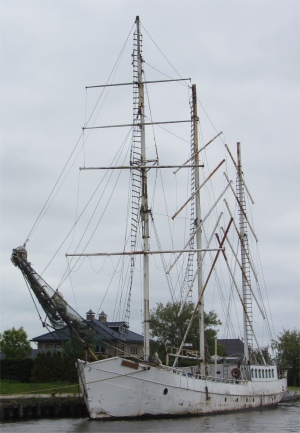
Dilapidated Tall Ship on the Van Harinxmakanaal
|
Meryl woke up after a really refreshing sleep. The half-bottle of wine with her meal, together with the ample dollops of liquorice flavoured cough medicine before bed, had really knocked her out.
After toast and marmalade, we were on our way along the Van Harinxmakanaal, through a green and pleasant land full of sheep, Frisian cattle and horses. The rich farmland smells made us think we were in the countryside, which of course we were for most of the journey. Occasionally we passed by small industrial areas, with boat yards, scrap metal merchants, gravel depots and other such enterprises. But for the most part of our journey today, the land was rural and full of bird song. Friesland, a not very populated region, is covered by a network of canals, at one time the only way of traversing the marshland as it was then. Rex and Meryl commented that there were far more canals in the north of the country than the south. Between the canals the land was laced with ditches.
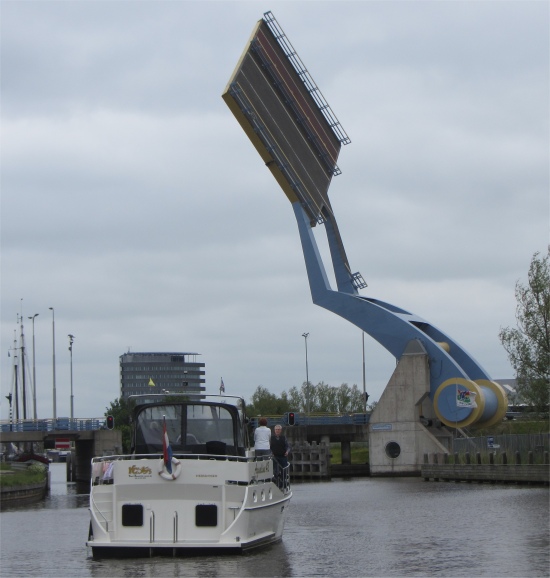
Amazing Lifting Bridge on Slauerhoffweg on the Outskirts of Leeuwarden
|
Many bridges traversed our route, usually requiring gilling about in front of the bridge until the bridge keeper opened it. Of course, when it was not part of his working day, or his/her lunch break, you just had to kick your heels and wait, including tying up if it was going to be a long wait. Train bridges were more problematic, you have to wait because the bridge opening times are determined by the train timetable.
The trick on lengthy trips is to travel in a loose convoy with other masted vessels. Bridges are inclined to be opened more promptly if there is a queue of vessels waiting to go through. We often came across yachts, noticeably of one particular nationality, that would for no apparent reason speed up and slow down in such convoys. This tendency irritated Rex.
Entering Leeuwarden, we had to pay some bridge dues, normally at the first bridge as a town is entered. The payment was carried out in a novel fashion. The fees would be posted on a large sign hanging from his bridge-operators office, as a boat approached the bridge close to his office, the eagle-eyed operator spotted the value of a note a crew member was waving in the air. He would insert the correct change in a clog, which he then lowered from a fishing rod. The crew member would catch the clog, remove the change and insert the note into the clog. A very civilised, personal, almost "poetic" way of paying a toll. It wouldn't be practical on the Dartford Tunnel though.
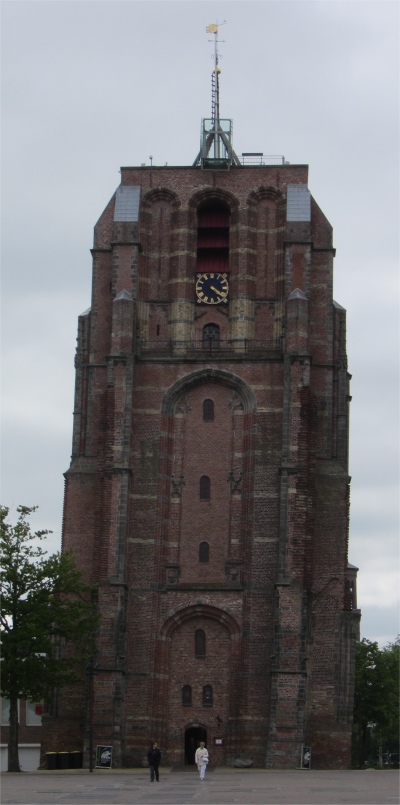
Oldehove - The Leaning Tower of Leeuwarden
|
We moored in the Municipal Moorings area, which the lady in Harlingen had described. It is conveniently on the standing mast route that twists and turns around the western side of the city centre. Our mooring was quite near the Prinsentuin garden, and we were located by delightful park area surrounded by lime trees, grassy banks and sadly liberal coatings of dog dirt. Once secured, I went off to check out the local toilet/shower facilities. I found a machine outside the facilities block, at which a group of elderly Germans were trying to work out how to operate it; the screen appeared blank. "Vielleicht der junge Mann kann die Maschine," said one of the old ladies. I felt flattered that she referred to me as a young man. They stood back, I inserted my bank card, touched the blank screen and hey presto I was in. The Germans gave an audible sound of "awe" as they saw this magic. A few key strokes and I had a mooring ticket for our boat, and a few more and out popped a card that would give us entrance to the facilities. My German friends were delighted when they saw how to operate this trickery, and I was showered with several, "Vielen Dank".
I returned to advise the others, and Rex mentioned that the Italians on a neighbouring boat were also keen to find out about the payment mechanism. I dutifully went off to advise them, piping up in my best Italian. Surprise, surprise, they were German. Hmmmm...... had I been wound up or had I found a flaw in Rex's normally superb linguistic skills?
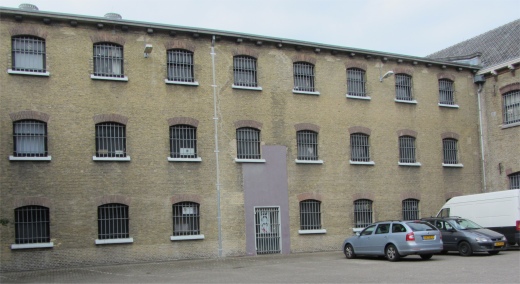
Inside the Blokhuispoort
|
We took a short stroll up by the canal and into the Prinsentuin garden proper, which has a beautiful setting right next to the canal. On an average summer day there can be as many as 300 boats tied up along the banks, many of which return again and again because of its convenient location. In 1648 this was the first park built at the request of Prince William Frederick of Nassau, as a tribute to the end of the 80-year war of Münster. It is today an oasis of calm in the center of Leeuwarden. This part of the city would remain closed to the public for some 150 years. It was eventually commissioned by King William l and became a public park. He donated the Prinsentuin to the Leeuwarden population.
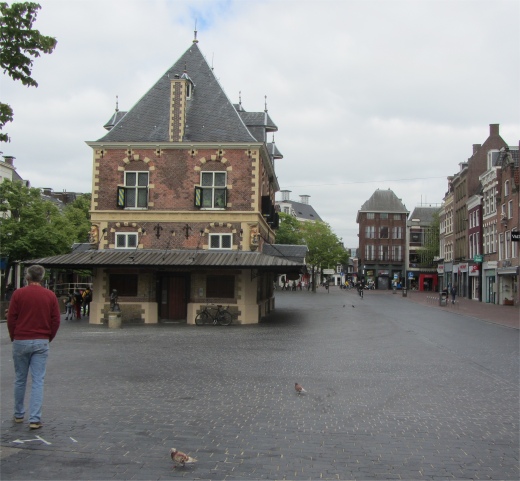
Rex and Pigeons on the Waagplein
|
Today we were lucky, we had arrived during a Prinsentuin Concert, one of the free concerts in the park on Sundays during the summer months. In several locations across the gardens, choirs and groups were singing in full voice, one group of female singers in particular producing excellent music. The park was heaving with people, it seemed
the thing to do.
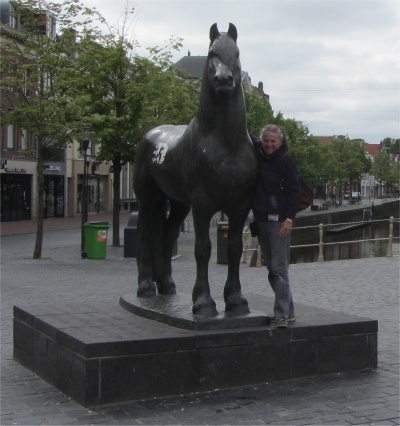
Meryl and Frisian Horse on the Waagplein
|
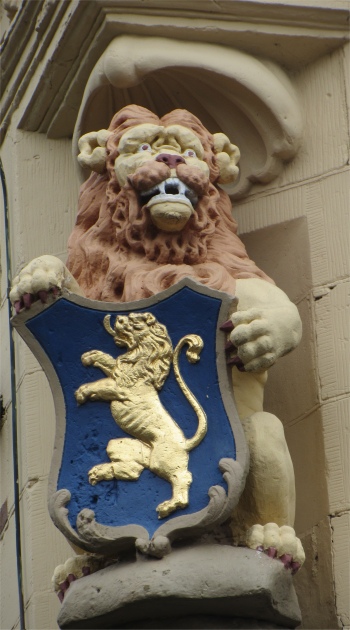
Statue on a Corner of the Waag
|
We left the park behind us and headed into the built up area of the city, the capital of Friesland and one of the historical eleven cities. Leeuwarden developed out of three terp or hill settlements that originally stood on an expanse of water known as the Middelzee. These merged in 1435 and were granted a municipal charter. Thereafter the town grew into an important trading center. With the silting up of the Middelzee, however, the town lost its harbour and became instead an agricultural market town and the chief center of the Ostergos region. From 1524 to 1580 the town was the seat of the Habsburg Stadholder, who was succeeded from 1584 to 1747 by Stadholders of the Nassau-Dietz family. In the 16th-18th centuries Leeuwarden was famed for its fine gold and silverware. Nowadays Leeuwarden is a modern city with a mostly 16th century city centre, with many canals and city walls (the structure of the city walls looks like a diamond) and museums. It is a university city with a laidback provincial air, its centre a haphazard blend of modern glass and traditional gabled terraces overlooking canals. It perhaps lacks the concentrated historic charm of many other Dutch citys, but it's an amiable old place.
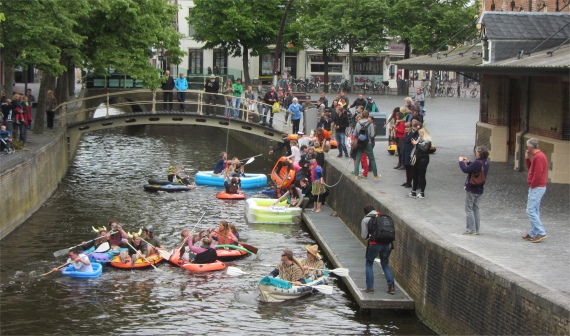
Student Raft Race
|
Several notable people were born in Leeuwarden: the artist Escher, Saskia van Uylenburgh, Rembrandt's wife, and of course the city's most famous daughter, the spy Mata Hari (1876-1917). She was born Gertrud Zelle. Hari became a renowned "exotic" dancer after an early but unsuccessful marriage to a Dutch army officer. Although the Netherlands was neutral during World War I, Hari seems to have accepted a German bribe to spy for the kaiser. The French intelligence service soon got wind of the bribe - partly because she was also supposed to be working for them - and she was subsequently arrested, tried and shot. What she actually did remains a matter of some debate, but in retrospect it seems likely that she acted as a double agent, gathering information for the Allies while giving snippets to the Germans.

Voorstreek with St Bonifatiuskerk in the Background
|
We ambled by The Oldehove, an unfinished brick church tower (1595-98) that was missing its top. It had been the beacon of Leeuwarden for centuries. Its height of about 40m was once considered extreme but is dwarfed nowadays by the office giants of Avero and Achmea at respectively 75m and 114m tall. We could spot the latter towers many miles away whilst traveling on the canal. The church to which the tower belonged was left unfinished because of the subsidence of the ground. To say that the tower is slightly off vertical is an understatement.

St Bonifatiuskerk
|
We took a closer look at the square situated at the foot of the leaning tower Oldehove. A long time ago there was a church on the Oldehoofsterkerkhof, and like the name suggests this used to be a cemetery. Some time ago the bodies in the graveyard were exhumed and now you can park your car in that very same spot in the underground parking garage. In the summer little fountains spew water over the square and its red cobblestones. The square in front of the Oldehove has been lowered so that in a period of frost a small layer of water will create an ice rink for recreational ice skating. On the round-about situated in a street called Harlingersingel, opposite of the Oldehove, is the statue of a cow "Us Mem" or "Our Mother" in Frisian (yes, they speak their own dialect in Friesland - Rex mastered this too). We were to see many statues and models of Frisian cows on our adventure.
We continued or walk, passing many old store fronts and beautifully restored monuments, and took a delight in walking by the many canals, flanked by cafes, antique shops and up-market clothes shops, with more of the same in the many side streets. In the 20th century, several canals were filled in and converted into streets. Fortunately the character of the streets surrounding these old canals has been preserved. We departed from a main canal that formed a southern border to the city centre near the Zuiderplein and walked across to the Blokhuispoort, an old prison. Now void of personnel and criminals, it is almost completely empty. It no longer meets the housing codes for prisons. The Blokhuispoort is a nationally recognized monument, and although probably empty for the next several years to come, there are few new plans for the building. It is going to be renovated and the former prison cells might be used by artists as studios.
Continuing on our travels, we stumbled across the Waagplein, a spacious square with a statue of a Frisian horse. In the center of Waagplein stood the Waag (1595-98) "Weigh House", a handsome building in Renaissance style in which butter and cheese were sold until 1884. It was now occupied by a bank on the ground floor and a restaurant on the upper floor. Today a large group of students in colourful clothing were climbing into all manner of rafts floating on the stretch of water between the Waagplein and Nieuwestad, all full of joy and laughter - perhaps exams had just finished. These amateur sailors then set off, seemingly in all directions, with much commotion and splashing, but generally travelling in a westerly direction, under a very wide, low bridge, the Lange Pijp, out the other side, and off into the distance laughing and shouting. It was fun to watch, and reminded me of my students rag week days over 40 years ago.
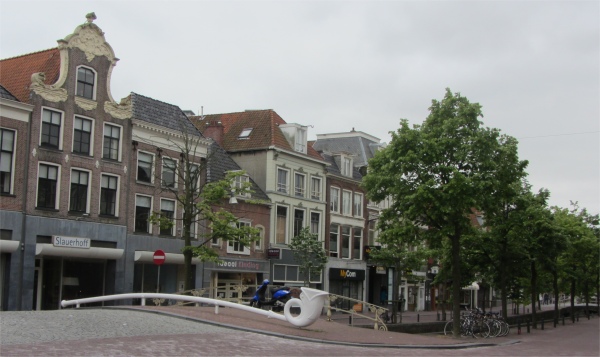
Large Pipes Around Here (Bridges over Canals in Leeuwarden are also Called Pijps)
|
We stopped off at a coffee shop on Nieuwestad. It was very much a student haunt, with groups of students sitting around tables chatting and tapping away on their laptops. It was a lovely atmosphere, with a kind of academic Bohemian air to it. Even the toilets were labelled in academic jargon, the two standard gender symbols denoting male and female derived from astrological symbols, denoting the classical planets Mars and Venus, respectively. These symbols have been in use since the Renaissance, and also denote elements in alchemy, specifically the metals iron and copper. They were first used to denote the effective gender of plants (i.e. sex of individual in a given crossbreed, since most plants are hermaphroditic) by Carolus Linnaeus in 1751. Apparently numerous variations of gender symbols have been developed in the context of LGBT (lesbian, gay, bisexual and transgender) culture since the 1990s.
Rex ordered his usual latte, while Meryl and I ordered hot chocolate. The latter was delivered as a glass of hot milk each, and we were each given a pot of chocolate buttons, which we poured into our hot milk and stirred. Truly delicious! The conversations surrounding us were very cosmopolitan, with as many German voices as Dutch.
Picking up the Voorstreek, the second largest canal in the city, surrounded by shops, we walked up it and took time out to explore the St Bonifatiuskerk, a neo-Gothic church built by P. J. H. Cuypers in 1882-84. During a hurricane in 1977 the upper portion of the steeple was completely torn off and fell to the ground. In the 1980's the steeple was rebuilt, this time using a steel construction. Sadly it was closed.
On our way back to
Duonita, we passed the Keramiekmuseum Princessehof, which Meryl would have dearly loved to visit, since she is very much involved in creating artistic artefacts out of stained glass. Sadly it was almost closing time, so we gave it a miss.
In the evening we visited a very local restaurant, in fact only 30m away from our vessel. From the outside it resembled an ice-cream parlour. However, inside it was quite spacious, well furnished with gorgeous walnut tables, warm and offered excellent food. We left - the last customers.
On our return to our vessel, we discussed plans for the next day, and also learned that our friend Alan had successfully managed his solo sail to Iceland.











